Bag of Bell (Vol 9): Rival fanbases might want to think twice before playing the Donovan Peoples-Jones card; Plus my top ancillary TV characters, Cheeto talk and Survivor talk (sorry!)
This post is unlocked and available for all readers.
Ahoy. Quick housekeeping item of note at the top: I’m trying out a format this week that I’m considering adopting as the new full-time mailbag template. I’ve enjoyed digging deep into some pretty sports-centric stuff over the last few weeks, but that’s also quite time-consuming. Instead of two or three “deep dives” in a given newsletter, I’m going to try and ID a weekly “big question” where I’ll dedicate a few thousand words and a good chunk of the newsletter to for that particular week. The remainder of the mailbag will be more of a grab bag of questions that can deal with sports, TV, life or anything else that you guys ask about, but I’ll try and keep those relatively short. As always, that will be drive by the types of questions y’all ask.
With that out of the way, let’s give this format a try.
This week’s big question
Twitter question from Nathaniel Madonna:

I talked about Michigan’s ability to get players drafted in my State of the Michigan Football Program piece a couple weeks ago. You can’t dispute that Michigan’s ability to get players drafted during the Jim Harbaugh era has been extremely impressive. But there’s another side of that coin, as Nathaniel points out with this week’s question. Yes, those 31 draft picks over the last five years are great, but there’s a considerable dearth of Day 1/Day 2 skill position players among those 31 players.
Just how bad is it? Here’s a table:
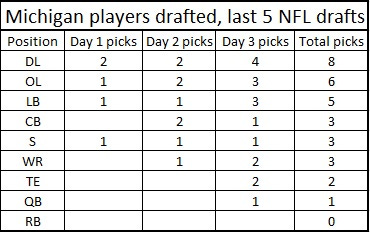
This table shows me two things. First, the four positions that most would classify as “skill positions” — WR, TE, QB and RB — are the four positions at the bottom of this table. That’s three draftees, two draftees, one draftee and a big fat zero, respectively.
It’s not any better when it’s narrowed down to the window Nathaniel mentions in his question (Day 1-2 picks), either. The first five positions have yielded at least two players each taken in Rounds 1-3 in the first five years of the Harbaugh era (a really impressive feat, for what it’s worth). But outside of one third-round pick WR, every other Michigan skill player drafted so far in the Harbaugh era has been a Day 3 (R4-7) selection.
So honestly, that could be the answer to your question right there and we could call it a day: Yes, Michigan’s lack of high-end skill players is a concern. Full stop.
But, I’ve always said most questions are much more complex than they appear, and this is no different. After doing some digging, I’ve found some pretty interesting things about skill position guys, highly touted recruits, college production and the NFL draft. Let’s pull up a chair, shall we?
—
I feel like the current narrative about Michigan skill players has popped back up because of Donovan Peoples-Jones’ fall in last month’s NFL draft — a fall that’s been put under a microscope because of analysis from unbiased, decorated journalists like Urban Meyer saying “Donovan Peoples-Jones Should Have Been A Top-10 Pick.”
Now, was Donovan Peoples-Jones' college career a disappointment? Yes. But let's not call the guy a complete bust or even a statistical outlier. He was a freshman All-American in 2017. He made All-Big Ten teams multiple seasons at multiple positions. And he got drafted. He certainly didn’t get drafted where fans would expect an elite recruit to be drafted. But he was drafted. And a dive into the numbers showed me that’s more of an accomplishment than most would think.
The guy throwing shade at Michigan in the video above should know that just as well, if not better, than basically everyone.
To see where DPJ fits on the disappointment scale, I decided to look at the last four draft-eligible recruiting classes and map out how things played out for each of those top-tier WR recruits.
Here’s a full accounting of the 51 WRs from the 2014, 2015, 2016 and 2017 recruiting classes to be national top-100 guys in their respective classes, regardless of position. It’s sorted from highest-ranked to lowest-ranked.
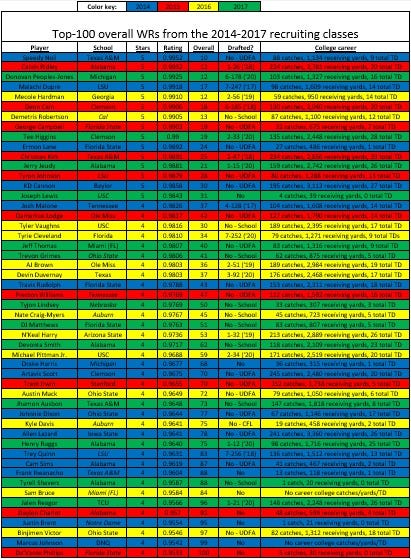
Since there’s a lot of information to disseminate from there, I’ll go ahead and share my five biggest takeaways from the data.
There were 13 WRs in the top 100 of the 247Sports Composite rankings in DPJ's recruiting class. Five of those 13 (38%) were drafted. The 2016 class has had six of 13 (46%) players drafted. The 2015 class had just three of its 10 (30%) drafted. And 2014 was the worst of all, with just three of 15 (20%). Altogether, that’s exactly one third (17 of 51) elite WRs eventually being drafted. That number probably inches up to the mid-to-high 30s next spring when a few of the WRs still in school get drafted (Devonta Smith is a lock, Tyler Vaughns and Jhamon Ausbon seem likely), but that’s still a pretty staggeringly low percentage, or at least it was to me.
If you think this data is skewed by failures from the high four stars rather than the five stars, take this stat into consideration: Of the 10 highest-ranked WR recruits over the last four draft-eligible classes (all five stars), DPJ has been the fourth highest-drafted player, trailing only Calvin Ridley (R1, 2018), Tee Higgins (R2, 2020) and Mecole Hardman (R2, 2019).
I’ll also guard against the “DPJ was just drafted for his potential” argument in this space, too. While his athleticism and high ceiling are certainly selling points, DPJ was also an above-average contributor among these 51 WRs in all three major receiving stats, too. He was in the 62nd percentile in total TDs (16), 56th percentile in catches (103), 52nd percentile in receiving yards (1,327).
Hard to see the italicized school names in that spreadsheet above, but 17 different players ending up playing at schools other than the ones they signed with out of high school. So if you were an elite WR during this window, you were just as likely to transfer colleges than you were to be drafted in the NFL draft.
One thing you don’t see a lot of on the chart? Big Ten representation. The SEC led all conference with 22 top-100 WRs signed out of high school during that period. The Big Ten had less than a third of that total with seven total signees. More than 85% of those players signed with either Ohio State or Michigan. The full tally by conference: SEC (22), ACC (10), Big Ten (7), Pac-12 (6), Big 12 (4), Independents/DNQs (2).
As mentioned above, only seven of the 51 players (13.7%) signed with Big Ten schools. And three of those seven ended up transferring to different schools.
Want to take a guess at which Big Ten WR is the only one of that whole bunch to get drafted? I’ll give you a hint: It’s the same one who led all seven of those receivers in total catches and total yards receiving, and finished just two touchdowns shy of leading that category, too, despite the fact that he only played three seasons and the vast majority of the rest played four.
Here’s how DPJ stacks up with four Ohio State signees (three of which stayed at Ohio State, the fourth of which ended up at Florida), one Nebraska signee (who has since transferred to Oregon State) and one other fellow Wolverine — Drake Harris, who grad transferred to Western Michigan to close out his career.
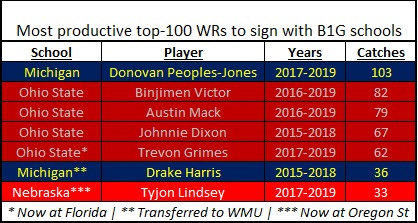

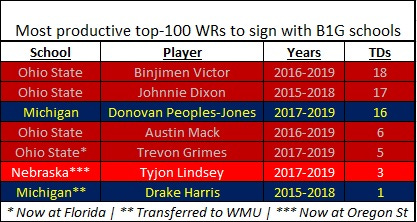
In fact, Ohio State going 0-for-4 in getting its highest-ranked WR signees drafted is the second-worst track record among all FBS programs to sign at least one top-100 WR during that period, trailing only Florida State (0-for-5).

Can’t imagine why Urban Meyer wasn’t bringing this up during draft weekend.
—
Now this isn’t designed to make excuses for Michigan’s lack of development of skill players. I just don’t think it’s fair to make DPJ the posterchild for it, and a lot of the data I found when digging deeper into the situation was pretty eye-opening to me.
As I mentioned at the top, I think the lack of high-end skill players at Michigan during the Harbaugh era is absolutely a legitimate concern. This includes a lack of high-end skill position recruits out of high school, but it also includes the lack of sub-top-100 recruits developing into elite college players/NFL prospects.
If we go back to the 11 Tier 1a, Tier 1b and Tier 2 teams I named in my State of the Michigan Football Program piece — Alabama, Clemson, Ohio State, Georgia, LSU, Oklahoma, Auburn, Florida, Michigan, Notre Dame and Penn State — Michigan stands out as an outlier when it comes to skill position players, and not in a good way.
Here’s a chart of notable players at each of the big three positions over the past five seasons. I’ve listed them in order of best to worst (in my opinion), and shaded in some tiers to show where I think there are large gaps.

Compare the guys in that top tier with the Tier 5 players I have listed for Michigan and Florida, and it’s like you’re looking at two different sports.
Unlike the recruiting numbers, where it’s Ohio State and Michigan doing the vast majority of the heavy lifting for the Big Ten, you can swap Michigan with Penn State when it comes to skill-position draftees.
Here’s which conferences and which schools are producing the most RBs and WRs in the first three rounds (sticking with the parameters used in the original question again — and I’m including RBs in this one, too, because I’m looking to make a broader point beyond DPJ).
By conference
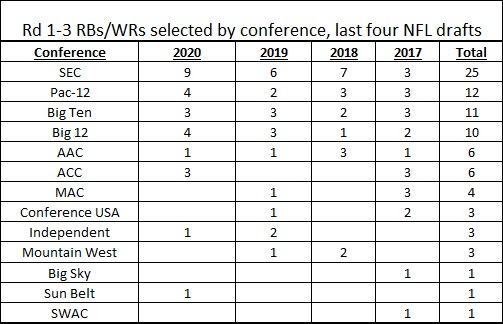
By school

Michigan is in that final group of 32 with one draftee in the last four drafts. And that pick (Amara Darboh), came at the tail end of the third round. He has eight career catches.
That is … not ideal. The silver lining? You can count everyone’s total on one hand, unless you’re talking about Alabama (or unless you’re Antonio Alfonseca, in which case you’ve got Alabama covered, too).
It’s hard to get skill guys drafted in the first two days of the draft. Michigan needs to have more than one skill guy drafted in the first two days of the draft over any random four-year period, let alone the four most recent years.
These are mutually exclusive statements. Both things can be true. In fact, both things ARE true.
—
My aim in these things isn’t to push someone toward a ledge or talk someone down from it. If there’s a narrative that I think is unfair, I’m going to go ahead and shoot that down for the sake of the athlete or team that’s being disparaged (or unrightfully praised). But I’m not in position to tell you how you should feel about things. I’m just giving y’all the information and letting the sunshine blowers do their thing and letting the people who want to be miserable continue to be miserable.
I think there are things to be concerned about. I’ve outlined them above. But I do think there’s reason for optimism going forward, too.
For example:
Michigan’s style of play
This one should be obvious. Formations like this were fun and made for good memes early in the Harbaugh era, but are they going to be yielding video game numbers that give RBs and WRs noteriety and help attract future generations of elite skill guys?

Michigan is better positioned in a modern Josh Gattis speed-in-space offense than it was with a Tim Drevno or a Pep Hamilton-led attack. Gone are the days of “pro-style” offenses being played in the NFL. Michigan was a little behind the times in this department, and that shows in a lot of the facts and figures above, but it caught up last season and is recruiting pieces that will help make the attack operate even more smoothly in future seasons.
Recent recruiting trends
Michigan’s last two recruiting classes have arguably yielded the two most promising skill position top-end hauls in Harbaugh’s first five full classes.

The top-ranked player in Michigan’s 2020 signing class was WR AJ Henning. The best RB in that class was Blake Corum, who had the third-highest rating among his fellow classmates. That’s far and away the top combined rank, besting the previous year’s record of Zach Charbonnet (3rd) and Cornelius Johnson (7th), good for a combined rank of 10th.
The 1-2 punch was reversed in terms of cumulative ranking. Charbonnet’s 0.9760 ranking (making his the second highest-ranked skill position player of the Harbaugh era, trailing on DPJ) combined with Johnson’s 0.9294 mark was good for a combined rating of 1.9054. The 2020 class combined rating of 1.8971 (Henning’s 0.9548 plus Corum’s 0.9423) was second best.
Current Wolverines poised to break out
The best thing that could happen for current and future generations: Have a couple players break out this season. And it’s certainly possible.
Zach Charbonnet was 4th in the Big Ten in rushing TDs last season as a true freshman even though he battled injuries basically the entire season. He would have easily been a 1,000-yard back had his body held up a little better. He could make the next step during his sophomore season and establish himself as one of the conference’s top backs. It’ll be tough with Hassan Haskins, Christian Turner, Chris Evans and Blake Corum competing for touches. But someone emerging as a go-to guy would be a good sign that someone was making a trancedent leap if they put all that competition in the dust.
I think a more likely spot is at WR, though. Nico Collins is your best bet. He would have been drafted had he entered the draft this offseason, but he came back to add to his resume. One would expect Gattis gave him some assurances that he’d get the opportunity to showcase himself upon his return. Ronnie Bell may not have the ceiling to step into Day 1-2 NFL Draft status, but a younger guy like Giles Jackson does. He showed flashes toward the end of last season and could be a strong candidate to make that leap this fall, too.
The more a player or two find ways to stand out next fall, the more that’s going to help in every facet — from perception to recruiting and everything in between. If Nico Collins becomes an All-American-type player, the more Michigan can market that success and tout its development. And the more likely it is that a high school player will want to be “the next Nico Collins.” There aren’t kids who want to be “the next Braylon Edwards” anymore. Or “the next Anthony Thomas.”
—
Michigan has been able to make stars in recent years, but it’s all on the other side of the ball.
If I was to make a table of notable defensive players similar to the one I did of notable skill players from the 11 top-tier schools in my rankings, Michigan’s Harbaugh haul of Devin Bush, Jabrill Peppers, Rashan Gary, Chase Winovich, Mo Hurst, David Long, Josh Uche, Taco Charlton, Khaleke Hudson, Chris Wormley, Jourdan Lewis, Delano Hill, Willie Henry and more would hold up against the best of the best in college football.
But in 2020, you’re simply not going to be able to break into the top tier of college football programs if your roster doesn’t have a handful of significant playmakers on offense, too. And that’s the roadblock Michigan is currently stuck at.
More mail
Twitter question from Noah Neidlinger:
The line that serves as the boundary for what is ancillary is a bit subjective, but here’s my best crack at a top 5, with the understanding that I’m breaking ties by choosing the more obscure character in most cases.
Creed Bratton, “The Office” — This should come as a surprise to nobody, and I almost feel guilty leading with this because it’s such a popular choice. But leaving him off just to be different would be more obnoxious than actually including him, and there’s a reason he’s always lauded for being a great ancillary character: because he’s a great ancillary character.
Moment: Either him hitting Meredith and running away during Toby's "Strike, Scream, Run" presentation or him showing up to Halloween in a blood-spattered shirt.
Roger Furlong, “Veep” — This spot could honestly belong to more than a handful of characters from Veep, but Furlong will get the nod for me because his scene-to-laugh ratio was pretty damn near 1:1 over the course of the series. FWIW, Jonah Ryan would have been my choice, but he became too much of a primary character in the later seasons of the series to be considered ancillary to me.
Moment: Any interaction between Furlong and his aide, Will. I’m personally fond of the relationship getting to the point where he had insulted Will so much that he started just letting Will choose his own insults as the series progressed. “Hey, Will, what do you move like?” “I move as slowly as a Mississippi detective investigating the murder of a young black man, sir.”
Rickety Cricket, “It’s Always Sunny in Philadelphia” — If you haven’t noticed yet, I’m a fan of over-the-top characters in Sitcoms. And Cricket may be the most over-the-top of them all. It’s particularly funny to me when you contrast it with the Cricket (/“Matthew”) we’re introduced to in Season 2 of the show — a clean-cut priest that just wants to make Dee happy. That makes the deterioration to homeless, crack-addicted, scar-ridden, blind, burn-victim Cricket 10 times funnier.
Moment: A lot to choose from here, but sign me up for his pro wrestling debut, when he wrestles under the name “The Talibum” and ends up getting his throat slashed by a trash can lid, an injury that ends up getting some, uh, “special attention” from feral dogs in future seasons.
Bob Loblaw, “Arrested Development” — Similar deal with Veep. Lots of directions you can go here. I’m choosing Bob Loblaw more because of the bits surrounding him than anything he actually saws. The thing that makes Arrested Development to great to me is the writing, and a lot of the recurring fun/dumb/clever witticisms are tied to the Bob Loblaw character.
Moment: The Bob Loblaw Law Blog, the Bob Loblaw Law Bomb and my personal favorite: Bob Loblaw No Habla Espanol.
Leon Black, “Curb Your Enthusiasm” — He might get too much screentime to be considered ancillary, but I think JB Smoove’s character needs to be included on this list. The juxtaposition between Leon and Larry is brilliant and even though he has next to nothing to do with anything that happens on the show (which is why I’m justifying his inclusion on this list), Leon is a key reason why Curb is (usually — ahem, s9) so good.
Moment: Either The Danny Duberstein-Michael Richards back-and-forth where Leon tries to convince the man behind Kramer to do the Seinfeld reunion, or Leon bestowing Larry the nickname of “Long Ball Larry.”
Honorable mention: Ralph Wiggum (The Simpsons), Jean-Ralphio (Parks and Rec), Kenneth Parcell (30 Rock), Herbert (Family Guy), Russ Hanneman (Silicon Valley), Butters (South Park).
Twitter question from Mitchell Gladstone:

I thought this season was excellent. I feel comfortable calling it the best finale ever, and I really think it’s a strong contender for best season ever. I know there’s always a worry about being a prisoner of the moment, but I actually think a bigger mistake I see from people in recent years is being overly conscious of that and overcorrecting themselves as a result. Nobody (short of Jeff Probst) wants to start throwing out “best season ever” comments because they think it’s disrespecting previous seasons. But I think this season is going to hold up very, very well long term when it’s sized up against other seasons. It had everything: The most competitive cast ever, the best f3 in terms of diversity (three people who played very strong, very different games), some very memorable moments (Denise/Queenslayer, Tony flipping votes in tribal, the best firemaking battle in the show’s history, etc.).
When I listed my greatest seasons of all time in a previous newsletter, the top 3 were Heroes vs. Villains, Fans vs. Favorites and Cagayan, and I said if there was a gun to my head that I’d give the nod to Cagayan. Well the winner of Cagayan was the same winner as Winners at War, and if you’re stacking the two seasons against each other, there’s a lot of checks in the Winners at War side of the tale of the tape (competition being the main one). I don’t like the idea of the Edge of Extinction and I think that will always be a criticism of this season, but I think the fact that Tony won by 10+ votes against someone who basically played the most flawless game possible coming out of the Edge could actually do the show a lot of favors going forward.
As for the second part of your question, I selfishly don’t want the show to wind down. I think Survivor is different than a scripted TV show that you want to see go out on top (Breaking Bad) so it doesn’t spiral out of control and become a caricature of its past self (Dexter). The show has done a very good job of evolving so seasons don’t end up being so similar. And while you can’t always bat 1.000 (as mentioned above, I don’t like the idea of EoE), the show has done a pretty good job of keeping wrinkles that are positive additions and “failing fast” with twists and concepts that don’t work out well. As long as people keep watching and the game doesn’t feel stale, I say keep turning ‘em out.
I definitely prefer new-cast seasons at this stage of the show’s history. I think producers relied too much on returning players in the 20s/early 30s and didn’t do a good job of creating new stars. But I also think producers have realized that and gone with new casts more in recent years and done a good job of injecting some new blood into the series (Devens in 38, Christian in 37). Maybe I’m reading too much into it, but it sure seemed like a passing of the torch moment in the finale where the Boston Robs, Parvatis, Tysons and Kims of the world all more or less gave retirement speeches after the final returnee challenge. I do like returnee seasons like Winners at War, but the show needs to be all or nothing when it comes to seasons involving returning players. The seasons where they bring back two or four favorites aren’t fair to the new players and usually end up yielding some of the more annoying twists, with said twists typically being designed as ways to keep the fan favorites on our TV screens longer.
The show seems to have identified that it’s easiest/most cost effective to film seasons back-to-back in Fiji and have shows center more around themes than locations, and I’m all on board with that. I don’t care about the location. I’m fine with them filming in Fiji in perpetuity. The show to me is much more about the strategy and gameplay to me than the survival aspect/surrounding location. Not sure if that changes at all in our COVID-19 current reality, but all things equal, sign me up for Fiji forever.
The biggest thing on my future season wishlist: Let’s dial it back on the advantages a bit. Idols, idol nullifiers and other rewards can make for great TV. But let’s not oversaturate the game with these to the point where it waters down the actual gameplay.
E-mail question from Jared Farber:
Settle a debate for my wife and I. We’re eating a lot more chips in the post-COVID world. I say regular Cheeto’s are the best variety of Cheeto’s, she swears by the Puffs. What are your overall Cheeto variety power rankings?
I will gladly help settle this debate. You both lose. Congratulations.
Any of the following four flavors are superior to your respective favorites: Flamin’ Hot Cheetos, Xxtra Flamin’ Hot Cheetos, Crunchy Cheddar Jalapeno Cheetos, Crunchy Cheese Cheetos.
If this inquiry is strictly to break the tie between you and your wife by choosing which of your answer is the least flawed, then you win. Puff Cheetos get a 0/10 ranking from me because that is my one-year-old’s go-to snack. Having to clean up after a mobile toddler is hell in a vacuum. Adding bright orange residue to every inch of his body makes it 20 times worse.
Ok, now I’m hungry. And I probably have some orange walls to go help clean up. See you all next week.





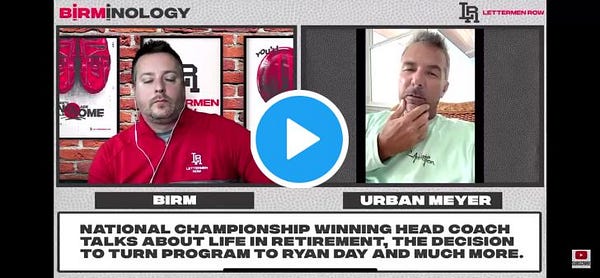

Subscribed. Move over Michigan analysts, there's a new kid in town and he's not playing around.
I love the new format.